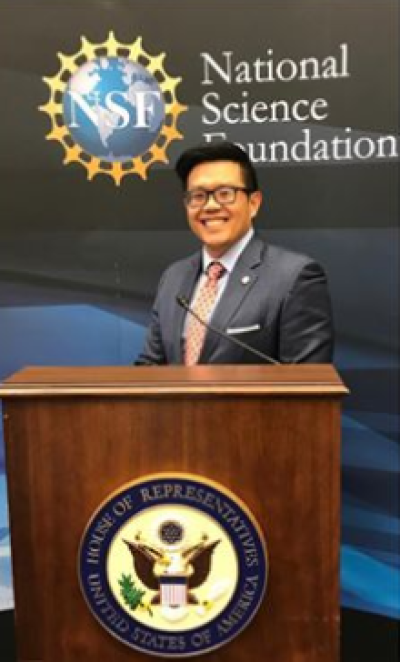When Winnie Litten first began teaching the Amgen Biotech Experience (ABE), the technology she was able to teach to her students was not yet even available in colleges. It was 1992 and her school, Oak Park High School in Southern California, was one of the first two high schools to participate in the cutting-edge labs. Nearly 30 years later, Litten continues to teach students through the ABE program, enabling them to explore real-world applications of transformative technology.
The first school to participate in ABE was Newbury High School, which was not only close to Amgen headquarters in Thousand Oaks, Calif., but also very close to Oak Park. Litten has fond memories of working with Hugh Nelson, who was teacher #1 for ABE and helped develop the original program.
“Back in those days, when I needed to pick up supplies for the lab, I would drive onto the Amgen campus and park right in front of a building,” she recalls. “I would always bring Hugh a banana for a snack, we would just get a cart, wheel it into a lab room/supply room, and start pulling things off the shelves. It was like going to a grocery store. I need a little agar, a few bacteria, a few pipettes … unbelievable to think about now. Who gets to do their shopping at Amgen?”
Now, the program has expanded to more than 160 schools in the Los Angeles area alone and nearly 1,000 schools worldwide. Although the program has evolved to keep up with the changing technology, Litten says that the basic technology—cutting and splicing DNA and transforming bacteria—is the same.
“What has changed the most drastically are the sheer numbers of students who have access to the labs,” she says. “Initially, we just transferred antibiotic resistance. Later, that became a selective marker as the lab evolved to transfer a eukaryotic gene into a prokaryotic cell. The ability to isolate the protein, just as insulin is harvested from bacteria, was also a pretty big leap.”

She also says that the speed of the technology has changed. “For example, gel electrophoresis used to take the entire period, but now it takes 15 minutes and each student has their own. We use ‘green’ agents now to view the DNA. The support materials and training for teachers has increased as well.”
The impact of these labs for her students has been tremendous, Litten says. Among the hundreds of students she has taught, many have gone on to study science, including Vince Tedjasaputra.
When Litten taught Tedjasaputra in 10th grade, his mother passed away from cancer. She remembers him as a dedicated student who worked hard, and she has maintained close contact with him over the years. He now works for the National Science Foundation (shown at right).
When Tedjasaputra was at the University of California, San Diego, as an undergraduate student, he did the same DNA recombination lab in his biochemistry class that he had done in high school through ABE. “Fast forward 10 years, 3 advanced degrees, and 18 publications later,” he once told Litten, “I can say that Amgen wet lab experience started it all."
Yet another former student of Litten’s is now a dermatologist. She told Litten: ABE “introduced me to PCR. It is a test I order on many patients as a dermatologist to diagnose viral conditions. It is wonderful that in high school I was introduced to such applicable concepts that I use in my career every day.”
In addition to teaching so many students, Litten has lent her considerable expertise to other teachers, helping to share ABE and expand the reach of biotech labs. “I am very passionate about helping other teachers because by helping other teachers I can have a positive impact on more students,” she says.
Looking ahead to the next two decades, Litten envisions that ABE will continue to educate students and to evolve as the technology evolves. “Anything that contributes to the thoughtfulness of science and the scientific method is critically important, now more than ever,” she says.
Her advice to other teachers is to use it to help students connect in a substantive way to the science. “The real learning and understanding of future applications comes from knowing and understanding the science—focus on that first and then the lab,” she says. “To do this lab well, you need time, and time is precious. The ABE labs are always worth the time they take to prepare the lab materials, prepare the students, and perform and analyze the labs. The students feel the responsibility and the power of these lab techniques, and it never leaves them.”
The success of ABE over the past 30 years is a testament to the hard work of so many individuals. Says Litten: “I have tremendous gratitude for leaders like Hugh Nelson, Marty Ikkanda, and others who worked the lab bench in its infancy. I am thankful for all the teachers staying late after a long day of teaching labeling and filling microfuge tubes, driving to pick up and return supplies on their own time and own dime because they are passionate about educating our youth. I am thankful for Oak Park Unified School District; they are wonderfully supportive.”
And she concludes: “I am thankful for the Amgen Foundation and their continuous support—because this program gives me the distinct privilege of watching the pride on my students’ faces as they learn pipetting techniques, cutting, ligating, separating DNA, and transforming a living organism because of what they did, what they understand, and what they can apply.”
This is not our first time talking with Winnie. Check out this archived interview.
